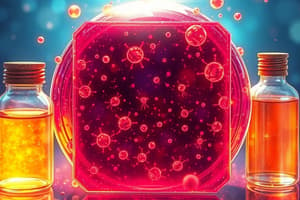Podcast
Questions and Answers
What is the molecular weight of IgG molecules?
What is the molecular weight of IgG molecules?
- 200,000 Daltons
- 150,000 Daltons (correct)
- 180,000 Daltons
- 120,000 Daltons
Which chromosome codes for the heavy chains of IgG molecules?
Which chromosome codes for the heavy chains of IgG molecules?
- Chromosome 2
- Chromosome 14 (correct)
- Chromosome 18
- Chromosome 22
What is the purpose of di-sulphide bonds in IgG molecules?
What is the purpose of di-sulphide bonds in IgG molecules?
- To differentiate between IgG and IgM molecules
- To connect the heavy and light chains (correct)
- To produce antibodies in response to infection
- To recognize and bind to specific antigens
What is the primary function of an antibody in the immune system?
What is the primary function of an antibody in the immune system?
Which of the following is an example of a naturally occurring antigen in the body?
Which of the following is an example of a naturally occurring antigen in the body?
Which of the following is NOT a type of immunity?
Which of the following is NOT a type of immunity?
What is the purpose of injecting antigens into small mammals to produce antibodies?
What is the purpose of injecting antigens into small mammals to produce antibodies?
What are hybridomas in the context of antibody production?
What are hybridomas in the context of antibody production?
What is the term for the biochemical compound in a sample that is detected or analyzed in immunoassays?
What is the term for the biochemical compound in a sample that is detected or analyzed in immunoassays?
What is the main purpose of ELISA?
What is the main purpose of ELISA?
What is the primary site of antibody production in the immune system?
What is the primary site of antibody production in the immune system?
What is the term for the binding between an antigen and its homologous antibody?
What is the term for the binding between an antigen and its homologous antibody?
What is the main difference between polyclonal and monoclonal antibodies?
What is the main difference between polyclonal and monoclonal antibodies?
What is the term for the large glycoprotein molecules produced by B-lymphocytes in response to antigens?
What is the term for the large glycoprotein molecules produced by B-lymphocytes in response to antigens?
What is the shape of the majority of human glycoprotein antibodies?
What is the shape of the majority of human glycoprotein antibodies?
What is the purpose of T-lymphocytes in the immune system?
What is the purpose of T-lymphocytes in the immune system?
What is the primary purpose of an enzyme-conjugated anti-immunoglobulin in an ELISA assay?
What is the primary purpose of an enzyme-conjugated anti-immunoglobulin in an ELISA assay?
In an indirect ELISA, what is the function of the secondary antibody conjugate?
In an indirect ELISA, what is the function of the secondary antibody conjugate?
What is the main difference between a direct ELISA and an indirect ELISA?
What is the main difference between a direct ELISA and an indirect ELISA?
What is the purpose of the Elisa reader in an ELISA assay?
What is the purpose of the Elisa reader in an ELISA assay?
What is the advantage of using a sandwich ELISA over a direct ELISA?
What is the advantage of using a sandwich ELISA over a direct ELISA?
What is the purpose of the capture antibody in a sandwich ELISA?
What is the purpose of the capture antibody in a sandwich ELISA?
What is the typical application of a sandwich ELISA?
What is the typical application of a sandwich ELISA?
What is the role of the substrate in an ELISA assay?
What is the role of the substrate in an ELISA assay?
What is the primary purpose of using a conjugated antigen in competitive ELISA?
What is the primary purpose of using a conjugated antigen in competitive ELISA?
What is the significance of the signal produced in competitive ELISA?
What is the significance of the signal produced in competitive ELISA?
What is the purpose of including quality control samples in the ELISA kit?
What is the purpose of including quality control samples in the ELISA kit?
How are the results of the competitive ELISA typically analyzed?
How are the results of the competitive ELISA typically analyzed?
What is the purpose of drawing a standard curve in competitive ELISA?
What is the purpose of drawing a standard curve in competitive ELISA?
What is the significance of the initial positive results in competitive ELISA?
What is the significance of the initial positive results in competitive ELISA?
Why is it important to read the kit instructions carefully before starting the competitive ELISA?
Why is it important to read the kit instructions carefully before starting the competitive ELISA?
What is the purpose of using duplicate or triplicate samples in competitive ELISA?
What is the purpose of using duplicate or triplicate samples in competitive ELISA?
Flashcards are hidden until you start studying
Study Notes
Immunoassay
- Immunoassay is a technique that uses the binding between an antigen and its homologous antibody to identify and quantify the specific antigen or antibody in a sample.
- Samples can be urine, saliva, tears, or any biochemical materials.
Antigens
- Antigens are substances that stimulate the production of an antibody when they enter the body.
- Examples of antigens include strange biological particles, bacteria, and viruses.
Analyte
- The analyte is the biochemical compound in a sample that is detected or analyzed in immunoassays.
- The analyte can be either an antibody or an antigen.
Antibodies
- Antibodies are large glycoprotein molecules produced by B-lymphocytes in response to antigens.
- Each antibody is designed to bind to a specific surface binding site or epitope on the antigen.
- There are millions of different types of antibodies circulating in an individual's bloodstream.
Structure of An Antibody
- Antibodies are shaped like a Y and are found in the blood, lymph, and intestine.
- The antibody is composed of 2 long (heavy) chains and 2 short (light) chains connected by di-sulphide bonds.
- The antibody recognizes and binds to the specific antigen and determinant specific region on the antigen surface.
Antibody Production
- Antibodies can be produced in the laboratory through various methods:
- Injecting an antigen into small mammals to produce small quantities of antibody.
- Injecting antigens into larger animals to produce large quantities of antibody.
- Producing monoclonal antibodies by combining antibody-secreting B-lymphocytes with cancer cells.
ELISA (Enzyme Linked Immunosorbent Assay)
- ELISA is a biochemical immunology technique used to detect the presence of an antibody or an antigen in a sample.
- ELISA is used to detect hormones, drugs, some toxins, and genetic modified crops.
Non-Competitive ELISA Requirements
- Antigens (Ag) fixed to a solid surface (immobilized).
- Antibodies (Ab) in solution to be tested.
- Enzyme-conjugated Anti-immunoglobulin (Antibody against the antibodies being tested for).
- Substrate binds to enzyme and produces color.
- Color intensity proportional to bound enzyme-Ab.
Indirect ELISA
- Antigen is immobilized on a plate.
- Primary detection antibody is added and binds to the specific antigen forming an antigen-antibody complex.
- Secondary antibody conjugate with the enzyme is added to the complex.
- Substrate is added and produces a signal proportional to the amount of antigen bound in the well.
Sandwich ELISA
- Capture antibody is coated on a microplate.
- Two specific antibodies are used, forming a sandwich shape with the antigen.
- Conjugated enzyme-detection antibody is added and binds to an additional epitope on the target protein (antigen).
- Substrate is added and produces a signal that is proportional to the amount of analyte present in the sample.
Competitive ELISA
- Capture antibody is coated on a microplate.
- Conjugated antigen is used to compete for binding with the antigen present in the sample.
- Note: more antigen present in the sample means less conjugated antigen will bind to the capture antibody.
- Substrate is added and the signal produced is inversely proportional to the amount of protein present in the sample.
Analysis of Results
- The standard curve is drawn using the absorbance readings from the spectrophotometer.
- The concentration of the unknown samples is determined by finding the corresponding concentration on the standard curve.
- Results can also be analyzed using software, which plots the standard curve and determines the concentration of the samples.
Facts about the Results
- The quality control sample concentration is determined from the standard curve and must be within the range given by the kit manufacturer.
- The initial Positive results are determined by the color change of the solution in the ELISA wells, while negative results are determined by the lack of color change.
Studying That Suits You
Use AI to generate personalized quizzes and flashcards to suit your learning preferences.



